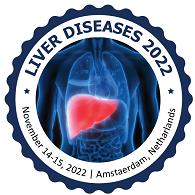
Edinga Eyebe Bertille Elodie
National Laboratory of Public Health, Ministry of Health, Yaounde, Cameroon
Title: Biological evaluation of liver fibrosis using a noninvasive test FIB4 in adults in the city of Yaounde
Biography
Biography: Edinga Eyebe Bertille Elodie
Abstract
Abstract:
Background:Liver fibrosis can be induced by chronic viral hepatitis, toxic hepatitis, metabolic diseases and autoimmune diseases. It is staged when the diagnosis of chronic liver disease is made, in order to detect complications, such as cirrhosis and hepatocellular carcinoma. But is often asymptomatic. The aim of this study was to determine the prevalence of liver fibrosis, using the combined platelet count, Alanine amino transferase, Aspartate Amino transferase and age - FIB-4 in an adult population with no history of known chronic liver disease.
Objective:The general objective of our study was to determine the prevalence liver fibrosis using FIB-4 score in the adult population in the city of Yaoundé.
Methods:We conducted a prospective analytical study. The study population was made of participants aged above 21years old, with no known history of chronic liver disease. The measurement of transaminases enzymes (AST, ALT) activities and platelet count were carried out at the laboratory of the Yaounde Central Hospital, by autoanalyzers using the principles of photometric and the account combining impedance and micro-kinetics respectively. The FIB-4 score was calculated according to the formula proposed by Sterling et al. The statistical analysis of the data collected was carried out by SPSS software version 20.0.The result was significant when p <0.05.
Results:A total of 183 participants were included, sex ratio 1. A third of the study population, 33.9% had liver fibrosis (FIB-4 score >1.30) of whom a quarter 24.2%, had an advanced fibrosis, (FIB-4 score >2.67). Some risk factors were associated to liver fibrosis: age ( above 37 years), sex (female), metabolic syndrome and diabetes.
Conclusion:At the end of this study , we found liver fibrosis on participants with no history of known chronic liver disease. Some of them had advanced fibrosis. Hence the need of systematic screening of patients for liver fibrosis.

